 This weekend, there’s been lots of furious chat on blogs and Slashdot about the EULA that comes with SonyBMG’s audio CDs.
This weekend, there’s been lots of furious chat on blogs and Slashdot about the EULA that comes with SonyBMG’s audio CDs.
An EULA? What’s that? I hear you cry. An End User Licensing Agreement (EULA) is something that has been shipping with software packages for a very long time – the cold-hearted view of them is they impose restrictions on the purchaser while absolving its producers from any liability.
To have an agreement shipping with an _audio CD_ in itself is pretty strange. The EULA may well be related to the software that is shipped on the protected CDs, not the music – but this is now unimportant as the generally held view is that it is for the music.
It certainly has got the goal of a few – but it’s the terms of this 3,000 word EULA that has most up in arms. Some of the highlights/lowlights of it are
- If you move out of the country, you have to delete all your music. The EULA specifically forbids “export” outside the country where you reside.
- If you file for bankruptcy, you have to delete all the music on your computer. Seriously.
- You can’t keep your music on any computers at work. The EULA only gives you the right to put copies on a “personal home computer system owned by you.”
The full list is detailed on the EFF site.
All of this builds up on the now huge story of SonyBMG’s choice of software on some of their US released audio CDs. Called XCP, originally designed to ‘assert’ SonyBMG’s rights over their music CD’s, it installs itself on any computer where the audio CD is played. The user of the disk isn’t asked if this is OK, or even told that the software is installing itself. The software then hides itself using something called “rootkit.”
The really big problem for SonyBMG is that virus writers are now using this rootkit exploit to deliverer their viruses.
 Many have reacted to RootKit by saying that they feel it is ‘safer’ for them to download their music from unlicensed file sharing services, as they aren’t exposing themselves to unauthorised pieces of software installing on their machines.
Many have reacted to RootKit by saying that they feel it is ‘safer’ for them to download their music from unlicensed file sharing services, as they aren’t exposing themselves to unauthorised pieces of software installing on their machines.
SonyBMG have said they will stop selling music CD’s using XCP, but the damage to the Sony name has been done.
It’s all going wrong
A while back Sony, the parent company, had a revelation – that they needed to look outside their Sony Silo and start of embrace open formats. We saw MP3 being supported on their music players, where they’d always insisted on using their propriety content protections scheme ATRAC3. I even saw DivX supported on their DVD players, where DivX had previous been thought of as the content pirates tool.
Sony had (I stress had) started to claw back against Apple and the other companies that they’d been losing out to. As of now, it looks like they’ve slipped even further behind. For goodness sakes, they’ve even got groups of people suggesting Boycott Sony and 3488 have, so far, signed an anti-Sony petition.
Sadly for Sony, it doesn’t end there
In digging through SonyBMG’s code, Finn Matti Nikki has located references to LAME, an open source, MP3 encoder library, within the code used by SonyBMG’s version of the XCP software.
As Matti says, “I’d say this indicates that the executable has been compiled against static LAME library, which happens to be LGPL. I don’t have any further evidence about this, other than lots of data from libmp3lame being included and easy to find.” Let us translate – the LGPL (Lesser General Public License) provides certain freedoms and restrictions in the use of the software covered by it.
These include needing to make the source code to the open-source libraries available and the source code and executable code of their programs.
Without abiding by these rules, they are breaking the licensing terms of the content. Carrying out the exact act they the music companies are loudly decrying in their customer.
Where now for Sony?
 SonyBMG have managed to completely undo the small, patient steps that Sony, the hardware business, has been taking to gathering favour with the equipment buying public.
SonyBMG have managed to completely undo the small, patient steps that Sony, the hardware business, has been taking to gathering favour with the equipment buying public.
The idea of Sony owning content and hardware businesses always appears to be a great idea – they’d win all around. The reality is turning out to be very different.
There is a tension between the content business, who want to restrict movement of content, and the hardware business that wants to set the purchaser free. Whether a comfortable balance between these can ever be struck is unclear.
What is clear is that it appears that this CD story is nearly out of control for Sony. Someone at the most senior level at Sony needs to grab hold of this and do something radical. Our suggestion for a surefire, credibiliy-straightening maneuver? Reject DRM.
LGLP
SonyBMG on XCP
Wikipedia on LAME
LAME
Slashdot – Sony’s EULA Worse Than Its Rootkit?
 If you’ve owned a few digital cameras or PDAs and switched brands a couple of times over the years, you’ll probably already have a formidable collection of non-compatible memory cards wasting away in your drawer.
If you’ve owned a few digital cameras or PDAs and switched brands a couple of times over the years, you’ll probably already have a formidable collection of non-compatible memory cards wasting away in your drawer. Much as we hate to give any kudos to yet another memory card format, that’s a mighty impressive capacity and offers enough storage space to turn mobile phones into fully fledged, iPod-worrying MP3 players.
Much as we hate to give any kudos to yet another memory card format, that’s a mighty impressive capacity and offers enough storage space to turn mobile phones into fully fledged, iPod-worrying MP3 players. Sony has announced the Japanese release of two new laptops featuring the Intel Duo Core processor.
Sony has announced the Japanese release of two new laptops featuring the Intel Duo Core processor. The new super-skinny SZ series (0.9″ wide) comes with either a 945GM Express or the GeForce Go 7400 graphics card which offers an unusual SPEED/STAMINA switch.
The new super-skinny SZ series (0.9″ wide) comes with either a 945GM Express or the GeForce Go 7400 graphics card which offers an unusual SPEED/STAMINA switch.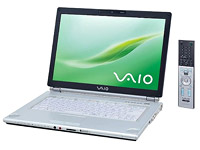 Sony F TV Series
Sony F TV Series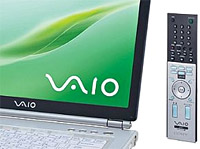 According to Sony Japan’s website, the laptops will be available in a range of configurations and made available in Japan over the next few weeks.
According to Sony Japan’s website, the laptops will be available in a range of configurations and made available in Japan over the next few weeks.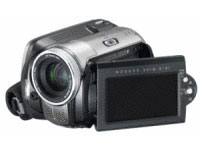 JVC has unveiled the flagship model to its extensive range of Everio hard drive camcorders, the GZ-MG77.
JVC has unveiled the flagship model to its extensive range of Everio hard drive camcorders, the GZ-MG77. In the highest resolution mode, Ultra Fine, users can record 7 hours and 10 minutes of video at 9 Mbps.
In the highest resolution mode, Ultra Fine, users can record 7 hours and 10 minutes of video at 9 Mbps.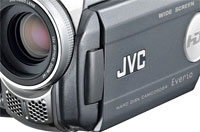 Video can be recorded in both standard and widescreen aspect formats, with an option to record stills.
Video can be recorded in both standard and widescreen aspect formats, with an option to record stills.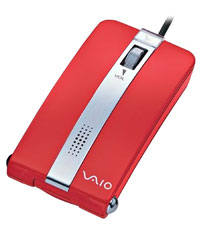 No idea if we’re ever going to see it turning up in Blighty any time soon, but we love this crazy new Sony VN-CX1 USB optical mouse-phone.
No idea if we’re ever going to see it turning up in Blighty any time soon, but we love this crazy new Sony VN-CX1 USB optical mouse-phone.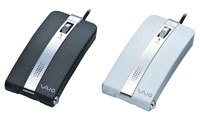 The clever stuff happens when a call comes in.
The clever stuff happens when a call comes in.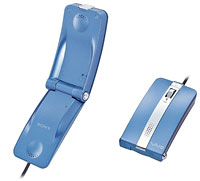 A potential problem might arise if you wanted to use the mouse when you’re on a call, but we think you can just switch to speakerphone mode. Or maybe not (the translated press announcement goes on about ‘knitting machines’ so it’s a bit vague).
A potential problem might arise if you wanted to use the mouse when you’re on a call, but we think you can just switch to speakerphone mode. Or maybe not (the translated press announcement goes on about ‘knitting machines’ so it’s a bit vague). Although the VN-CX1 doesn’t look like the most comfortable mouse we’ve ever seen, it’s small and light enough (45.5 × 23.9 × 89.2 mm, 67gms) and certainly looks a fun product.
Although the VN-CX1 doesn’t look like the most comfortable mouse we’ve ever seen, it’s small and light enough (45.5 × 23.9 × 89.2 mm, 67gms) and certainly looks a fun product.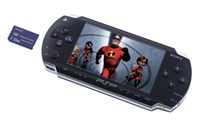 TiVo have announced the release of new software, slated for the first quarter of 2006 that will let owners watch recorded television shows on their Sony PSPs and video iPods.
TiVo have announced the release of new software, slated for the first quarter of 2006 that will let owners watch recorded television shows on their Sony PSPs and video iPods. This development is a further blow to TV network schedulers and their much-relied on conventional prime time programmes. This theory is torn apart when mobile viewers are able to watch programmes recorded the previous night, on the go.
This development is a further blow to TV network schedulers and their much-relied on conventional prime time programmes. This theory is torn apart when mobile viewers are able to watch programmes recorded the previous night, on the go.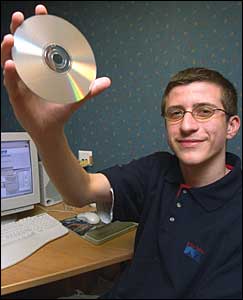 Because Criminals Make the Best Police Officers
Because Criminals Make the Best Police Officers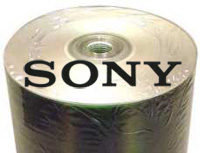 The other law other are saying have been broken by SonyBMG, and this is one that could land them in BIG legal difficulties, is
The other law other are saying have been broken by SonyBMG, and this is one that could land them in BIG legal difficulties, is  This weekend, there’s been lots of furious chat on blogs and Slashdot about the EULA that comes with SonyBMG’s audio CDs.
This weekend, there’s been lots of furious chat on blogs and Slashdot about the EULA that comes with SonyBMG’s audio CDs. Many have reacted to RootKit by saying that they feel it is ‘safer’ for them to download their music from unlicensed file sharing services, as they aren’t exposing themselves to unauthorised pieces of software installing on their machines.
Many have reacted to RootKit by saying that they feel it is ‘safer’ for them to download their music from unlicensed file sharing services, as they aren’t exposing themselves to unauthorised pieces of software installing on their machines. SonyBMG have managed to completely undo the small, patient steps that Sony, the hardware business, has been taking to gathering favour with the equipment buying public.
SonyBMG have managed to completely undo the small, patient steps that Sony, the hardware business, has been taking to gathering favour with the equipment buying public. Sony have launched the PSP Media Manager for the PlayStation Portable, an iTunes-like application designed to make it easy to shunt music, movies, photos and other content off a PC and onto PSPs and synchronise PC content with the PSP.
Sony have launched the PSP Media Manager for the PlayStation Portable, an iTunes-like application designed to make it easy to shunt music, movies, photos and other content off a PC and onto PSPs and synchronise PC content with the PSP. Supported image formats include .bmp, .jpg, .gif, .png, and .tif, with a bundled utility to backing up game saves to the PC.
Supported image formats include .bmp, .jpg, .gif, .png, and .tif, with a bundled utility to backing up game saves to the PC. The boxed version containing the USB lead and five free song downloads will be available form Sony’s Connect music from November 22 for $29.95 (~£17, ~e24), with the downloadable version already available (clearly without the USB lead – matter transfer via the Internet is being worked on) from the official Sony Media Software site for $19.95 (~£11, ~e16.5).
The boxed version containing the USB lead and five free song downloads will be available form Sony’s Connect music from November 22 for $29.95 (~£17, ~e24), with the downloadable version already available (clearly without the USB lead – matter transfer via the Internet is being worked on) from the official Sony Media Software site for $19.95 (~£11, ~e16.5).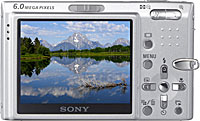 Sony continues to build on the success of its ultra-slim DSC-T digital still camera range with the release of the six megapixel Cyber-shot DSC-T9 model.
Sony continues to build on the success of its ultra-slim DSC-T digital still camera range with the release of the six megapixel Cyber-shot DSC-T9 model.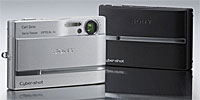 “Our T Series set the standard for slim, stylish, point-and-shoot cameras with fine image quality,” said James Neal, director of digital imaging products at Sony Electronics.
“Our T Series set the standard for slim, stylish, point-and-shoot cameras with fine image quality,” said James Neal, director of digital imaging products at Sony Electronics.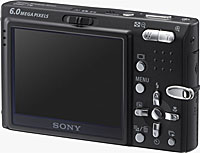 The DSC-T9 offers shutter speeds from 30 to 1/1000 second, Multi-pattern, Centre-weighted, or Spot metering, five white balance presets and 10 scene modes.
The DSC-T9 offers shutter speeds from 30 to 1/1000 second, Multi-pattern, Centre-weighted, or Spot metering, five white balance presets and 10 scene modes.